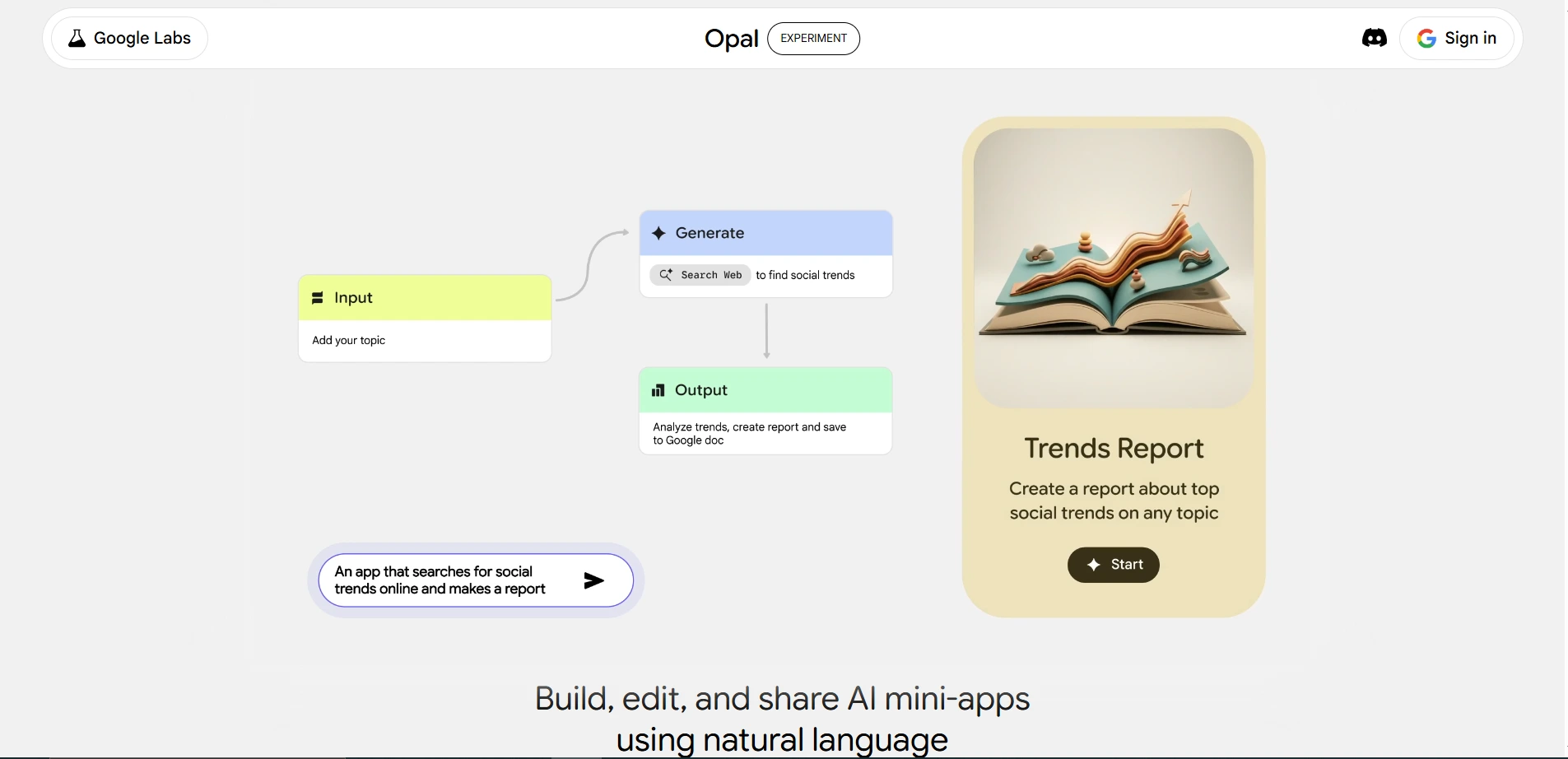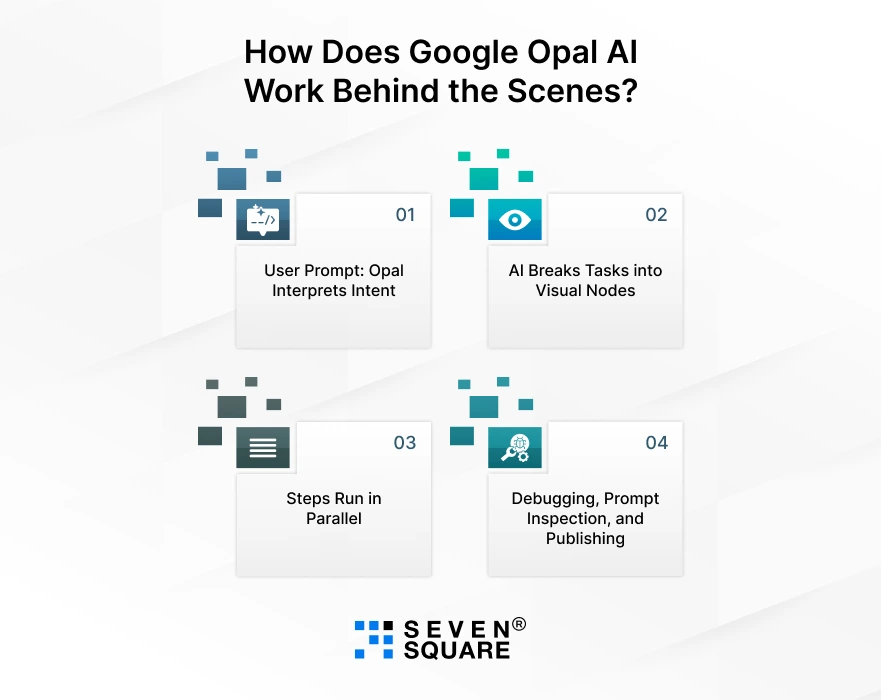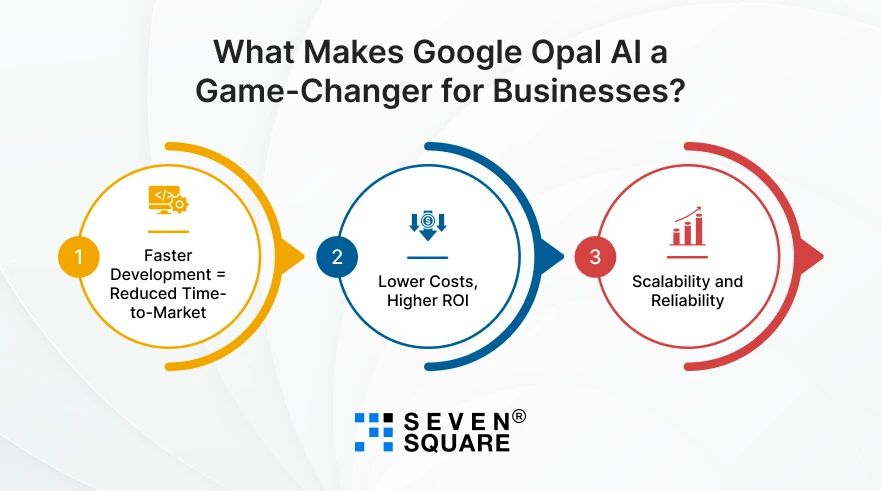What if you could build a full app simply by describing your idea?
That’s exactly what Google Opal AI, the latest AI app builder from Google Labs, allows you to do. With Opal, you don’t need to code or design from scratch.
You just describe your goal like, “Build a booking app for yoga classes with payment integration,” and the Google Opal AI instantly creates a working prototype.
Think of it as chatting with a developer who understands your intent and turns it into an app in minutes.
For startups, this means faster MVP launches. For enterprises, it means less time spent on manual workflows.
And for non-technical teams, it’s a way to build tools that once required full development teams.
We explore how tools like Google Opal AI and its Vibe Coding platform can help businesses innovate faster, reduce costs, and test ideas at record speed.
In this blog, you will learn how Vibe Coding works & some of the key Google Opal features to make app development flawless.
What Is Google Opal AI? A Quick Overview

Google Opal AI is like having a personal AI developer sitting beside you, ready to turn your ideas into functional apps.
Built by Google Labs, this AI app builder lets anyone create apps just by describing what they want in simple language.
You don’t need to understand frameworks, syntax, or UI design. Simply tell Opal what you have in mind, like:
Create a task manager that sends reminders and lets teams share to-do lists.
Within seconds, Opal interprets your intent and generates a working version of your app that you can preview, modify, and publish.
Here are a few Google Opal features that make it different from typical no-code tools:
- Visual Workflow Editor: Every part of your app, from actions to logic, is visible and editable using the Opal workflow editor.
- Prompt-Based Creation: Build apps through descriptive prompts instead of manual code.
- AI-Based Logic Flow: Opal understands the relationships between your ideas and automatically connects them into workflows.
- Mini-App Publishing: Once ready, you can instantly publish and share your Opal AI mini apps online.
Google Opal AI simplifies development so you can focus on what matters: Your product vision and business goals.
We help teams explore tools like Opal Google Labs to speed up MVPs, automate workflows, and scale faster with AI-based solutions.
What Is “Vibe Coding”? (And Why It’s Different from No-Code Tools?)
So, what is vibe coding, and why is everyone calling it the future of app development?
Vibe coding means coding through intent, not syntax.
Instead of typing out hundreds of lines of code, you express your idea in natural language, your “vibe” and the AI translates it into a functional app.
Example:
“Build me a meeting scheduler with Google Calendar integration.”
Opal listens, understands, and delivers.
| Type | How It Works | Best For | Example |
| Traditional Coding | Write code manually | Developers | React, Python |
| No-Code Tools | Drag & drop components | Designers, startups | Bubble, Adalo |
| Vibe Coding (Google Opal AI) | Describe your app in text | Anyone | Opal from Google Labs |
Unlike no-code or low-code platforms, Google Opal AI focuses on natural language app building; it doesn’t just provide blocks, it understands context.
We believe vibe coding and platforms like Opal are trying to turn an idea into an app instantly, which is perfect for entrepreneurs who want to innovate faster.
How Does Google Opal AI Work Behind the Scenes?

Here’s the step-by-step workflow on how Google Opal AI can be used to create apps from just a sentence.
1. User Prompt: Opal Interprets Intent
- You describe your app idea using natural language. For example, “Build a fitness tracker that logs daily workouts.”
- Opal uses advanced AI models to understand your intent & the vibe behind your request.
2. AI Breaks Tasks into Visual Nodes (Workflows)
- Once it understands your idea, Opal divides the process into smaller visual steps called nodes that you can see in this Opal workflow.
- Each node represents an action, database query, or screen design.
3. Steps Run in Parallel (Improved AI Speed)
- As updated by Google, Opal’s engine now runs multiple processes in parallel, which means your apps are generated and tested faster.
4. Debugging, Prompt Inspection, and Publishing
- You can open any node, see the AI’s reasoning, tweak the prompt, and instantly publish your mini app online.
You can think about this process as:
Prompt → Workflow → App → Publish
This is how Google Opal AI converts your simple ideas into interactive, shareable apps; no syntax, no code, just intent.
See how this natural language app builder could integrate with modern development workflows, making hybrid AI-human collaboration even more powerful.
Real-World Use Cases: Turning Ideas into Apps with Google Opal AI
Google Opal AI has gone through beta testing; it’s time for startups, enterprises, and agencies to approach app development.
The concept of “vibe coding” isn’t just experimental, it’s opening real opportunities for businesses that want to move faster, spend less, & innovate.
Here’s how different industries can benefit from Google Opal AI for businesses and startups:
1. Startups: Prototype MVPs Faster
- Startups can use Google Opal AI to convert an idea into a working MVP in hours instead of months.
- You simply describe what your app should do, like “Create a booking system for yoga studios,” & Opal’s vibe coding platform builds it for you.
- We help startups refine these AI-built apps into market-ready products with integrations, UI polish, and scalability improvements.
2. Enterprises: Automate Workflows
- Large enterprises are using Google Opal AI to automate repetitive internal processes.
- From task management to HR automation, Opal’s AI app builder simplifies workflows by transforming business needs into executable logic.
- We’ve helped enterprises integrate Opal-built tools with existing systems like CRMs, ERPs, and APIs to ensure smooth data flow across departments.
Learn more about the Open Generative AI Model Meta Llama.
What Makes Google Opal AI a Game-Changer for Businesses?

We believe Google Opal AI shows a major change, not just in app creation, but in who can create.
This AI-based vibe coding platform democratizes development for founders, teams, and enterprises who used to rely solely on developers.
1. Faster Development = Reduced Time-to-Market
- With Google Opal AI for startups, businesses can move from idea to deployable app in a fraction of the time.
- By simply describing their goals in natural language, users can skip coding entirely and focus on testing, scaling, and improving their product.
2. Lower Costs, Higher ROI
- This vibe coding platform drastically reduces initial investment while increasing experimentation speed, a key advantage for startups & SMBs.
3. Scalability and Reliability
- Google Opal AI’s underlying infrastructure is backed by Google Cloud and trained on millions of workflows, ensuring reliability.
Whether you’re building customer portals, data dashboards, or workflow automation systems, the best use cases for Google Opal vibe coding extend across industries.
How We Can Help You to Build Smarter Apps with Google Opal AI?
We specialize in helping businesses, startups, and agencies to use the full power of Google Opal AI and Vibe coding platforms. Here’s why companies trust us:
- We guide teams on how to use Google Opal AI to build mini apps and implement prompt-based workflows effectively.
- From idea to deployment, we help you change concepts into functional apps using the latest AI app builder technologies.
- Our team customizes Opal workflow editor setups according to your business processes, ensuring smooth automation.
- We connect Opal-built apps with APIs, CRMs, Google Workspace, and Android apps for smooth enterprise operations.
- We help startups create MVPs faster using Google Opal for businesses and startups, saving time and development costs.
Want to Customize Your App with Google Opal AI? Contact Us Now!
Google Opal AI vs. Traditional Development: Which One Wins?
Should your business rely on Google Opal AI or go for custom-coded development?
| Feature | Google Opal AI | Traditional Development |
| Speed | Minutes to hours | Weeks to months |
| Flexibility | Great for prototypes, limited for complex apps | Fully customizable |
| Cost | Very low (AI-driven) | Higher (requires dev team) |
| Maintenance | Auto-managed by Google | Developer-managed |
| Scalability | Good for small to medium apps | Excellent for all scales |
| Ease of Use | Non-technical friendly | Developer-only |
So who wins? It depends.
- For quick MVPs, prototypes, and workflow tools, Google Opal AI and vibe coding are unbeatable.
- For highly custom, enterprise-grade, or multi-system products, traditional or low-code development still reigns.
We help businesses decide when to choose vibe coding tools like Google Opal AI and when to go for a more robust custom solution.
Our team even combines both approaches, using Opal for the front end and traditional frameworks like React or Node.js for backend scalability.
Is Google Opal AI the Future of App Creation?
The rise of Google Opal AI marks a turning point in how we build websites & apps.
From startups to global enterprises, vibe coding helps anyone to go from idea to app with the help of AI.
We see Opal AI as the foundation of a smarter, faster, and more accessible development future.
Whether you want to experiment with AI app builders, automate your workflows, or scale your product using vibe coding, we’re here to make it happen.
FAQs
- Google Opal AI is used to build mini apps using vibe coding, where users create apps through natural language prompts instead of coding.
- Currently, Google Opal AI offers limited free access via Google Labs, but future plans may include tiered pricing depending on usage & integrations.
- Vibe coding works best for small-to-medium workflows.
- It may struggle with very complex logic or multi-layered backend systems, but can be extended with expert support.
- Apps built using Google Opal AI follow Google’s security standards, but businesses should still implement additional layers like API encryption and role-based access.